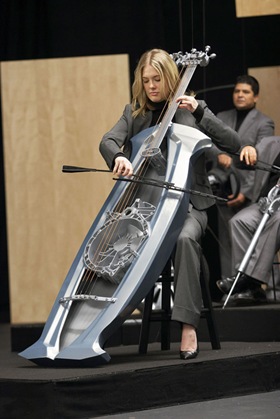It’s always fascinating to me how people hear, what they thing of as “real” or “authentic,” and what meaning they find in the things they listen to.
Yesterday, we got a glimpse of a new car advertisement for Ford in the UK featuring instruments constructed from automobile components:
Interview: Building a Musical Ensemble Out of Ford Focus Car Parts
What you see on the screen, of course, is not literally what you hear — the TV ad and soundtrack are edited together, and this is a car ad, not a documentary. But quite a few readers (and even blogs elsewhere) wondered if they were actually hearing instruments constructed from the Ford Focus — or if there was some audio fakery going on, as well.
Following up on our interview (which was evidently an exclusive for CDM, whatever that’s worth), sound designer Bill Milbrodt actually called me last night and we got to have a long chat about the whole process.
Here’s the short answer:
Yes, the instruments are really made from a Ford Focus. (The strings are conventional strings, which has a huge impact on timbre, but until Ford starts putting something that can substitute for strings into their cars, you’ll have to live with that.) Yes, musicians really did play them. Yes, you really do hear that recording (edited) in the ad. Bill points out that they could have saved a lot of money by just creating props. This is, indeed, the real thing.
And yes, the musical effect is awfully close to classical music played on conventional instruments. That was apparently the requirement of the agency and director. The sound of the Car Music Project is very different — and I suspect a little closer to the tastes of the readers here. Here’s what the ensemble sounds like live, at least until we get live footage of the Ford Focus ensemble (got my fingers crossed for that):
I just find it really interesting that people reacted the way they did — and to the whole issue of authenticity and recordings. We’re both immediately suspicious of anything recorded, yet cling to the idea of a recording as a “factual record” — despite the fact that sound depends entirely on your point of view. Even with live sound, you might experience a different concert in a different part of the hall. With recordings, mic choice, mic placement, and other factors impact the sound even before someone’s had a shot at digital “manipulation.” You know that, I know that — but still, we have some sort of deeply-ingrained expectations about what a recording is, or what we want it to be, that go beyond even the technical knowledge of a group of practictioners.
Of course, it’s curiosity about how things are actually done that drives some of this site, so I say, keep asking questions and questioning your ears.
But, for the record, this ensemble is, for all practicality, real. And there’s really not a cello on that recording, I swear.
Here are the full technical details from Bill, with links to still more information — and this answer actually winds up going into more of the nuts and bolts (sorry) of how these instruments were used musically:
The music was recorded on the instruments at Capitol Records, Los Angeles prior to shooting. At the shoot, the musicians performed to a playback recording. Television is a visual medium and the shooting, which occurred on a sound stage at Universal Studios, L.A. was done over two days. The instruments had added ornamentation for the shoot. But what you hear is really our instruments … They were tested in the workshop in PA, tuned and refined, then tested again (a few times over). A week before we shipped them to L.A., Craig Richey, the composer, came to PA and we assembled the Car Music Project musicians with some additional hired musicians — Craig spent two days working with the instruments plus two four-to-five hour evenings with the instruments and musicians. This helped him adapt his music to the ensemble, and helped us to find out where we need further refinement to make the instruments better able to deliver Craig’s music.
What you hear in the recording is the car part instruments. Obviously, if someone made a mistake, they went back and re-tracked that instrument as they would in any contemporary recording. You need to know, too, that the musicians were terrific players. They were picked for their skill and for attitude. Other things: the flutes and reeds have holes and therefore required players who were comfortable with baroque flute fingering, similar to that of a recorder or wooden flute. Because of this, I have found, for the flutes and reeds, it is best to work with a flute player who plays reeds as opposed to a reed player who plays flutes. Also, for the spike fiddle, which is the violin-like instrument that is played vertically like a cello, it is best to work with a cello player. For a violin player who normally tucks his/her instrument under the chin, the fingering is upside down. So, a cello player just needs to adjust to the tuning and the smaller fingerboard — that’s where attitude comes in. A player with the right attitude — a love of the unusual and a love of problem-solving — jumps right in and starts figuring it out.
FORD FOCUS MICROSITE:
On the Ford Focus microsite, there is some video from Capitol Records (video #6 or #7 I believe). It is a little tricky to get there. 1) Go to the URL below. 2) Click the link for the Ford Focus microsite. Let it load. 3) Once loaded, go to the link on the right and choose “Media”. The videos summarize the process. But I believe video #6 or #7 has a bit of recording session footage. Here is the link:
http://www.ford.co.uk/safari/focmca/-/focmca_micro/-/-/-/-#
“CLASSIC FM” CLASSICAL MUSIC STATION WEB SITE:
At the bottom, there is an interview with Craig Richey, just below the interview with me. Check it out.
http://www.classicfm.co.uk/article.asp?id=565284
Finally, the commercial’s director is Noam Murro. The first requirement he put forth, before hiring us to create the instruments, was that the instruments must play and must play in tune. The Car Music Project instruments can also play in tune. However, they are of an earlier vintage and were built without experience, so they are a little trickier (But that’s what we like about them!)
I hope this helps.
Bill Milbrodt
Car Music Project

